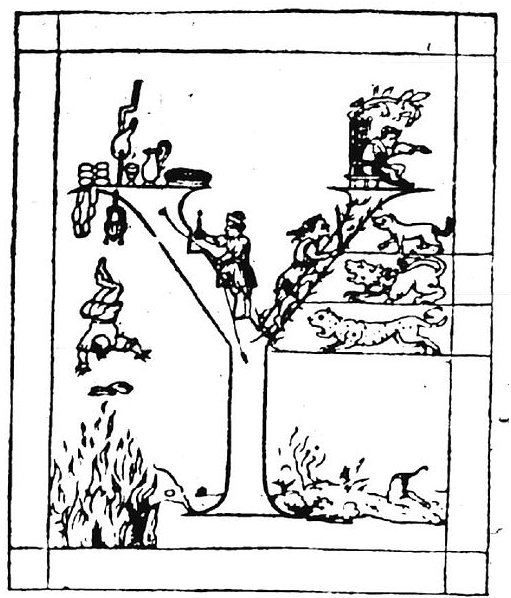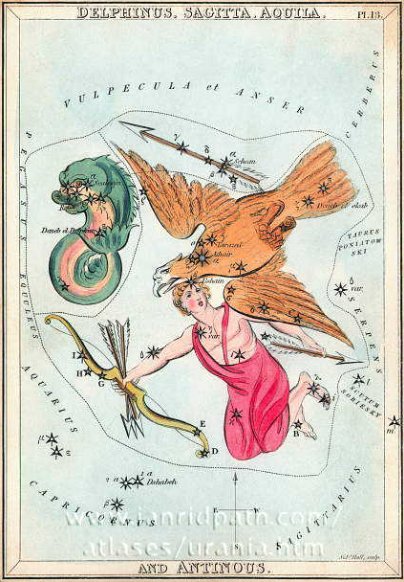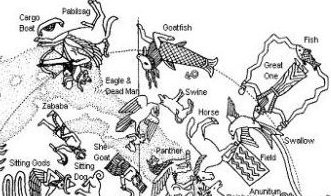The creator of the G text has put °October 7 (280) as the day for the 'interregnum',
i.e. 3 days later than in the C text - a phenomenon we
have encountered earlier when comparing Ga2-25 (225) at
τ Aquilae (*303) with Cb4-20 (91) at Altair (*300):
|
JULY 31 |
AUGUST 1 |
2 (214) |
3 |
4 (*136) |
5 |
6 |
 |
 |
 |
 |
 |
 |
 |
|
Ga5-22 |
Ga5-23 |
Ga5-24 |
Ga5-25 |
Ga5-26 |
Ga5-27 (137) |
Ga5-28 |
|
δ Muscae
(196.5) ,
VINDEMIATRIX = ε Virginis
(196.8) |
13h (197.8) |
APAMI-ATSA = θ Virginis,
ψ Hydrae (198.5),
DIADEM = α Com. Ber.
(198.9) |
AL DAFĪRAH = β Com. Ber.
(199.4) |
σ Virginis (200.4) |
γ Hydrae (201.0), ι Centauri (201.4) |
Al Simāk-12 /
Chitra-14 /
Horn-1 /
Sa-Sha-Shirū-20
(Virgin's
Girdle) /
ANA-ROTO-3
(Middle pillar) |
|
ξ¹ Centauri
(197.1),
ξ² Centauri
(197.9) |
MIZAR = ζ Ursae Majoris
(202.4),
SPICA
= α Virginis, ALCOR = 80 Ursae Majoris
(202.7)
SADALMELIK
(α Aquarii)
|
|
October 3 |
4 |
5 |
6 |
7 (*200) |
8 |
9 (282) |
|
°September 30 |
°October 1 |
2 |
3 |
4 (*196) |
5 (277) |
6 |
|
'September 6 |
7 (250) |
8 |
9 |
10 |
11 |
12 (*175) |
|
"August 23 |
24 (236) |
25 |
26 |
27 |
28 |
29 (*161) |
|
NAKSHATRA DATES: |
|
JANUARY 30 |
31 |
FEBRUARY 1 |
2 |
3 |
4 (400) |
5 (36) |
|
no star
listed (14) |
1h (15.2) |
Al Batn Al Hūt-26 /
Revati-28 / 1-iku |
ν
Phoenicis (17.4), κ Tucanae (17.6) |
no star
listed (18) |
ADHIL = ξ Andromedae
(19.3),
θ Ceti
(19.7) |
KSORA = δ Cassiopeiae
(20.1), ω Andromedae (20.6), γ Phoenicis
(20.8) |
|
β Phoenicis
(15.1), υ Phoenicis, ι Tucanae (15.6), η
Ceti, ζ Phoenicis (15.7) |
MIRACH = β Andromedae, KEUN MAN MUN
(Camp's South Gate) = φ Andromedae
(16.0),
ANUNITUM
= τ Piscium
(16.5),
REVATI = ζ Piscium
(16.9)
REGULUS (α
Leonis)
|
|
April 4 |
5 (460) |
6 |
7 |
8 |
9 (*384) |
10 (100) |
|
°March 31 |
°April 1 (91) |
2 |
3 |
4 |
5 |
6 (*16) |
|
'March 8 |
9 |
10 (*354) |
11 |
12 |
13 (72) |
3-14 |
|
"February 22 (53) |
TERMINALIA |
24 (*340) |
25 |
26 |
27 |
28 |
|
AUGUST 7 (219) |
8 (*140) |
 |
 |
|
Ga5-29 (139) |
Ga5-30
(383 = 242 + 1 + 140) |
|
71 VIRGINIS
(203.6) |
no star listed (204) |
|
October 10 |
11 (284) |
|
°October 6 |
7 (280) |
|
'September 13 (256) |
14 (*177) |
|
"August 30 (242) |
31 (*163) |
|
NAKSHATRA DATES: |
|
FEBRUARY 6 (*322) |
7 (403) |
|
δ Phoenicis
(21.5) |
υ Andromedae
(22.9) |
|
April 11
(101) |
12 (*387) |
|
°April 7 (97) |
8 (*383) |
|
'March 15 (74) |
16 (*360) |
|
"March 1 (60) |
2 (*346) |
|
Egyptian sky pillar |
 |
Phoenician waw |
 |
Greek
upsilon |
Υ(υ) |
|
...
Upsilon (uppercase Υ, lowercase υ;
Greek: ύψιλον, ıpsilon ... is the
20th letter of the Greek alphabet.
In the system of Greek numerals, Υ
has a value of 400. It is derived
from the Phoenician waw ... Waw (wāw
'hook') is the sixth letter of the
Semitic abjads ...
... Upsilon is known as
Pythagoras' letter, or the Samian
letter, because Pythagoras used it
as an emblem of the path of virtue
or vice. As the Roman writer Persius
wrote in Satire III:
and the letter which spreads out
into Pythagorean branches has
pointed out to you the steep path
which rises on the right.
Lactantius, an early Christian
author (ca. 240 - ca. 320), refers
to this:
For they say that the course of
human life resembles the letter Y,
because every one of men, when he
has reached the threshold of early
youth, and has arrived at the place
'where the way divides itself into
two parts', is in doubt, and
hesitates, and does not know to
which side he should rather turn
himself´...
 |

|
AUGUST 9 |
10 (222) |
11 |
12 |
13 (*145) |
 |
 |
 |
 |
 |
|
Ga6-1 |
Ga6-2 |
Ga6-3 |
Ga6-4 |
Ga6-5 (145) |
|
HEZE = ζ Virginis
(205.0), Southern Pinwheel Galaxy = M83
Hydrae (205.7) |
ε Centauri (206.3), κ Oct. (206.4) |
no star listed (207) |
τ Bootis
(208.2),
BENETNASH
= η Ursae Majoris
(208.5), ν Centauri (208.7), μ Centauri,
υ Bootis (208.8) |
no star listed (209) |
|
October 12 (285) |
13 |
14 |
15 (*208) |
16 |
|
°October 8 |
9 |
10 |
11 (*204) |
12 (285) |
|
'September 15 |
16 |
17 (260) |
18 |
19 (*182) |
|
"September 1 |
2 (245) |
3 |
4 |
5 (*168) |
|
NAKSHATRA DATES: |
|
FEBRUARY 8 (*324) |
9 (40) |
10 |
11 |
12 (408) |
|
ACHERNAR
= α Eridani
(23.3), χ Andromedae (23.6), τ
Andromedae (23.9) |
ALSEIPH = φ Persei
(24.5), τ Ceti (24.7) |
no star
listed (25) |
ANA-NIA-10 (Pillar-to-fish by) |
Al Sharatain-1 /
Ashvini-1 /
Bond-16 /
Mahrū-sha-rishu-ku-1
(Front of
the Head of Ku) |
|
χ Ceti
(26.1),
POLARIS
= α Ursae Minoris, BATEN KAITOS = ζ Ceti
(26.6),
METALLAH = α Trianguli
(26.9) |
SEGIN = ε Cassiopeia, MESARTHIM = γ
Arietis, ψ Phoenicis
(27.2),
SHERATAN
= β Arietis, φ Phoenicis
(27.4) |
|
4-13 |
April 14 |
15 |
16 (471) |
17 (107) |
|
°April 9 |
10 (100) |
11 |
12 (*22) |
13 |
|
'March 17 |
18 |
19 (78) |
20 (*364) |
0h |
|
"March 3 |
4 |
5 (64) |
6 (*350) |
7 |
|
... The king, wearing now a short, stiff
archaic mantle, walks in a grave and
stately manner to the sanctuary of the
wolf-god Upwaut, the 'Opener of
the Way', where he anoints the sacred
standard and, preceded by this, marches
to the palace chapel, into which he
disappears. A period of time elapses
during which the pharaoh is no longer
manifest.

When he reappears he is clothed as in
the Narmer palette, wearing the kilt
with Hathor belt and bull's tail
attatched. In his right hand he holds
the flail scepter and in his left,
instead of the usual crook of the Good
Shepherd, an object resembling a small
scroll, called the Will, the House
Document, or Secret of the Two Partners,
which he exhibits in triumph,
proclaiming to all in attendance that it
was given him by his dead father
Osiris, in the presence of the
earth-god Geb. 'I have run', he
cries, 'holding the Secret of the Two
Partners, the Will that my father has
given me before Geb. I have
passed through the land and touched the
four sides of it. I traverse it as I
desire.' ... |
Eb6-1 is very much like the
sign drawn around pharaoh in the Egyptian palace chapel into which - at the proper time - the pharaoh
would disappeare
from view for a while, to change his clothes,
and *Ca14-21 is basically also similar:
 |
 |
 |
 |
|
Eb5-35 |
Eb6-1
(837) |
Eb6-2 |
Eb6-3 |
|
Kua pipiri te hetu |
ko te mata no te
henua |
to ihe - te maro |
tara |
 |
2 |
 |
| *Ca14-21 (384) |
Ga5-30 (140) |
|
°October
4 (277) |
°October
7 (280) |
Should we count days from Gb1-1,
then Ga5-30 will be number 242 + 1 + 140 = 383.
And 837 (Eb6-1) = 27 * 31 = 383 + 454 (= 2 * 227).
This 3-day difference in a pair of
corresponding places is well ordered and the
distance from first to the second such pair is 84 (= 3 *
28 = 6 * 14 = 7 * 12):
 |
83 |
 |
|
Cb4-20 (483, 300) |
*Ca14-21 (384) |
|
°July 12 (193) |
°October
4 (277) |
|
Altair (*300) |
no star
listed (*384) |
 |
 |
|
Ga2-26 (56, 299) |
Ga5-30 (140, 383) |
|
°July 15 (196) |
°October 7 (280) |
|
τ Aquilae (*303) |
υ Andromedae
(*387) |
Notice how 384 (*Ca14-21) when
mirrored will be 483 (Cb4-20) = 3 * 161 = 21 * 23 (= 383 +
100).
July 12 (193) was the day when
the Sun reached Castor:
|
MAY 8 |
9 |
10 (130) |
11 |
12 |
13 (*53) |
 |
 |
 |
 |
 |
 |
|
Ga2-18 |
Ga2-19 |
Ga2-20 (50) |
Ga2-21 |
Ga2-22 |
Ga2-23 |
|
Ghost-23 (?) |
Al Dhirā'-5 /
Punarvasu-7 /
Mash-mashu-Mahrū-10 (Western
One of the Twins) |
ANA-TAHUA-VAHINE-O-TOA-TE-MANAVA-7
(Pillar for elocution) |
α Monocerotis
(115.4), σ Gemini (115.7) |
Mash-mashu-arkū-11
(Eastern One of the Twins) |
AZMIDISKE = ξ Puppis
(117.4) |
|
ρ Gemini (?) (112.1),
Eskimo Nebula = NGC2392 Gemini
(112.2)
ANTARES (α Scorpii)
|
CASTOR
= α Gemini
(113.4) |
υ Gemini (114.0),
MARKAB PUPPIS = κ Puppis
(114.7), ο Gemini (114.8),
PROCYON = α Canis Minoris
(114.9) |
κ Gemini (116.1),
POLLUX
= β Gemini
(116.2), π Gemini (116.9) |
|
July 11 |
12 (193) |
13 |
14 (*115) |
15 |
16 |
|
°July 7 |
8 |
9 |
10 (*111) |
11 |
12 (193) |
|
'June 14 |
15 |
16 |
17 (168) |
18 |
19 (*90) |
|
"May 31 |
"June 1 |
2 (*73) |
3 (154) |
4 |
5 |
|
NAKSHATRA DATES: |
|
NOVEMBER 7 |
8 |
9 |
10 (314) |
11 |
12 (*236) |
|
ν
Aquilae (Ant.) (295.0),
ALBIREO = β Cygni
(295.5) |
ALSAFI = σ Draconis
(296.0), μ Aquilae (296.3), ι
Aquilae (Ant.) (296.8),
κ Aquilae (Ant.) (296.9) |
ε
Sagittae (297.1), σ Aquilae
(Ant.) (297.4),
SHAM
= α Sagittae
(297.8) |
β
Sagittae (298.0), χ Aquilae
(298.3), ψ Aquilae (298.8) |
υ
Aquilae (299.1),
TARAZED = γ Aquilae
(299.3), δ Sagittae (299.6), π
Aquilae (299.9) |
Sravana-23 |
|
TYL = ε Draconis
(300.0), ζ Sagittae (300.1),
ALTAIR
= α Aquilae
(300.3), ο Aquilae (300.5),
BEZEK = η Aquilae (Ant.)
(300.8) |
|
January 10 |
11 |
12 (377) |
13 |
14 |
15 (*300) |
|
°January 6 |
7 (372) |
8 |
9 |
10 (*295) |
11 |
|
'December 14 |
15 |
16 (350) |
17 |
18 |
19 (*273) |
|
"November 30 |
"December 1 |
2 (336) |
3 |
4 |
5 (*259) |
Possibly there was a
connection between on one hand the
mortal Gemini twin and the Arrow
(Sham), while on the other hand Pollux
possibly might have been carried aloft by
the Eagle.


|
Piri
1. To join (vi,
vt); to meet someone on the
road; piriga, meeting,
gathering. 2. To choke:
he-piri te gao. 3.
Ka-piri, ka piri,
exclamation: 'So many!'
Ka-piri, kapiri te pipi, so
many shellfish! Also used to
welcome visitors: ka-piri,
ka-piri! 4. Ai-ka-piri
ta'a me'e ma'a, expression
used to someone from whom one
hopes to receive some news, like
saying 'let's hear what news you
bring'. 5. Kai piri, kai piri,
exclamation expressing: 'such a
thing had never happened to me
before'. Kai piri, kai piri,
ia anirá i-piri-mai-ai te me'e
rakerake, such a bad thing
had never happened to me before!
Piripiri,
a slug found on the coast,
blackish, which secretes a
sticky liquid.
Piriu,
a tattoo made on the back of the
hand. Vanaga.
1. With, and.
2. A shock, blow. 3. To stick
close to, to apply oneself,
starch; pipiri, to stick,
glue, gum; hakapiri,
plaster, to solder;
hakapipiri, to glue, to gum,
to coat, to fasten with a seal;
hakapipirihaga, glue. 4.
To frequent, to join, to meet,
to interview, to contribute, to
unite, to be associated,
neighboring; piri mai, to
come, to assemble, a company, in
a body, two together, in mass,
indistinctly; piri ohorua,
a couple; piri putuputu,
to frequent; piri mai piri
atu, sodomy; piri iho,
to be addicted to; pipiri,
to catch; hakapiri, to
join together, aggregate,
adjust, apply, associate,
equalize, graft, vise, join,
league, patch, unite.
Piria;
tagata piria, traitor.
Piriaro
(piri 3 - aro),
singlet, undershirt.
Pirihaga,
to ally, affinity, league.
Piripou
(piri 3 - pou),
trousers.
Piriukona,
tattooing on the hands.
Churchill. |
Twins stick together.
Twin sticks together:
|
In the morning of the
world, there was nothing but
water. The Loon was calling,
and the old man who at that
time bore the Raven's name,
Nangkilstlas, asked
her why. 'The gods are
homeless', the Loon replied.
'I'll see to it', said the
old man, without moving from
the fire in his house on the
floor of the sea. Then as
the old man continued to lie
by his fire, the Raven flew
over the sea. The clouds
broke. He flew upward, drove
his beak into the sky and
scrambled over the rim to
the upper world. There he
discovered a town, and in
one of the houses a woman
had just given birth.
The Raven stole the skin and
form of the newborn child.
Then he began to cry for
solid food, but he was
offered only mother's milk.
That night, he passed
through the town stealing an
eye from each inhabitant.
Back in his foster parents'
house, he roasted the eyes
in the coals and ate them,
laughing. Then he returned
to his cradle, full and
warm. He had not seen the
old woman watching him from
the corner - the one who
never slept and who never
moved because she was stone
from the waist down. Next
morning, amid the wailing
that engulfed the town, she
told what she had seen. The
one-eyed people of the sky
dressed in their dancing
clothes, paddled the child
out to mid-heaven in their
canoe and pitched him over
the side.
He turned round and round to
the right as he fell from
the sky back to the water.
Still in his cradle, he
floated on the sea. Then he
bumped against something
solid. 'Your illustrious
grandfather asks you in',
said a voice. The Raven saw
nothing. He heard the same
voice again, and then again,
but still he saw nothing but
water. Then he peered
through the hole in his
marten-skin blanket. Beside
him was a grebe. 'Your
illustrious grandfather asks
you in', said the grebe and
dived. Level with the waves
beside him, the Raven
discovered the top of a
housepole made of stone. He
untied himself from his
cradle and climbed down the
pole to the lowermost
figure.
Hala qaattsi ttakkin-gha,
a voice said: 'Come inside,
my grandson.' Behind the
fire, at the rear of the
house, was an old man white
as a gull. 'I have something
to lend you', said the old
man. 'I have something to
tell you as well. Dii hau
dang iiji: I am you.'
Slender bluegreen things
with wings were moving
between the screens at the
back of the house.
Waa'asing dang iiji,
said the old man again:
'That also is you.'
The old man gave the Raven
two small sticks, like
gambling sticks, one black,
one multicoloured. He gave
him instructions to bite
them apart in a certain way
and told him to spit the
pieces at one another on the
surface of the sea. The
Raven climbed back up the
pole, where he promptly did
things backwards, just to
see if something interesting
would occur, and the pieces
bounced apart. It may well
be some bits were lost. But
when he gathered what he
could and tried again - and
this time followed the
instructions he had been
given - the pieces stuck and
rumpled and grew to become
the mainland and Haida
Gwaii. (Robert
Bringhurst, A Story as
Sharp as a Knife. The
Classical Haida Mythtellers
and Their World.) |

|















